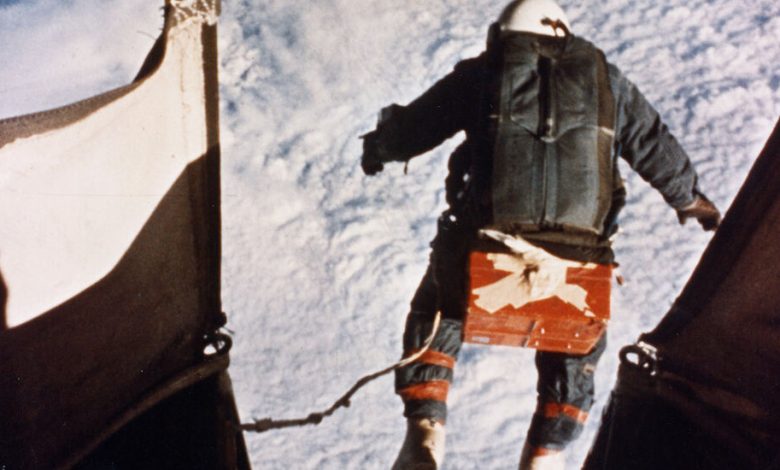Joseph Kittinger, a Record-Setter High in the Skies, Dies at 94

Leaping out of a balloon gondola almost 20 miles above the New Mexico desert on a summer’s day in 1960, Joseph Kittinger seemed like something out of science fiction.
He free fell for 13 seconds, protected against air temperatures as low as minus-94 degrees by specialized clothing and a pressure suit. And then his small, stabilizer parachute opened as planned to prevent a spin that could have killed him. He free fell for another 4 minutes and 36 seconds, descending to 17,500 feet before his regular parachute opened.
Mr. Kittinger, who died on Friday in Florida at age 94, never rivaled the original Mercury 7 astronauts or the men who walked on the moon in terms of celebrity, but he was an aviation trailblazer in his own right, paving the way for America’s first manned spaceflights.
Taking part in experimental Air Force programs in the skies over New Mexico in the late 1950s and early ’60s to simulate conditions that future astronauts might face, Mr. Kittinger set records for the highest balloon flight, at 102,800 feet; the longest free fall, some 16 miles; and the fastest speed reached by a human under his own power, descending at up to 614 miles an hour.
Those records were broken in October 2012 by Felix Baumgartner, a former Austrian paratrooper and professional daredevil, who rose more than 24 miles above the earth before beginning his free fall. Mr. Kittinger helped train Mr. Baumgartner, then guided him as the voice of mission control.
“Felix trusts me because I know what he’s going through — and I’m the only one who knows what he’s going through,” Mr. Kittinger said in the final hours before Mr. Baumgartner’s leap.
“We were in the pioneer part of the space program,” Mr. Kittinger told ABC News in 2008, when the Smithsonian presented him with its highest award, the National Air and Space Museum Trophy, for his lifetime achievements.
His death was announced by former United States Rep. John Mica of Florida, The Associated Press said. The cause was lung cancer. Mr. Kittinger, who is survived by his wife, Sherry, lived in the Orlando area.
After he concluded his ballooning for the Air Force, Mr. Kittinger went into combat. He flew 483 fighter-plane missions in the Vietnam War before he was shot down and taken prisoner. After retiring from the Air Force, he made the first solo balloon flight across the Atlantic Ocean.
“Life is an adventure, and I’m an adventurer,” he told U.S. News and World Report after his trans-Atlantic balloon flight, in 1984. “You just have to go for it. That’s the American way.”
Joseph William Kittinger Jr. was born on July 27, 1928, in Tampa, Fla., and grew up near Orlando. He became enthralled with planes when he saw a Ford Trimotor at a nearby airport and flew solo in a Piper Cub at 17. He attended the University of Florida for two years, then joined the Air Force in 1949.
After flying experimental jets and participating in aerospace medical research, he was recruited in the mid-1950s for Operation Man High, an Air Force project using balloons capable of high-altitude flight with a pressurized capsule or basket suspended from them. The aim was to determine whether humans could endure extended travel at spacelike altitude.
Making the first Man High balloon ascent in June 1957, Mr. Kittinger remained aloft for almost seven hours and climbed to 96,000 feet.
In 1958, he joined Project Excelsior, a program to test whether humans could survive a parachute jump from the edge of space, anticipating the possibility that a future astronaut might have to bail out of a capsule.
Mr. Kittinger piloted the Excelsior I balloon to 76,400 feet in November 1959, then prepared to jump out of his gondola. What happened next almost cost him his life.
His left arm caught on the door as he emerged, and the delay in freeing himself caused the premature deployment of the small parachute designed to prevent him from going into a catastrophic spin. The parachute caught Mr. Kittinger around the neck and sent him spinning. He tumbled toward Earth at 120 revolutions per minute, but his main parachute opened at 10,000 feet, as designed, slowing him down and saving his life.
A little more than three weeks later, he was aloft again, climbing to 74,400 feet in Excelsior II before jumping out.
In August 1960, soaring to 102,800 feet in the Excelsior III balloon, Mr. Kittinger eclipsed by almost 1,300 feet the altitude record set by Major David Simons of the Air Force in 1957 in his Man High II balloon.
And then Mr. Kittinger jumped from a gondola once more. “I said, ‘Lord, take care of me now,’” he recalled. “That was the most fervent prayer I ever said in my life.”
The right glove of his pressure suit had failed during his ascent, leaving his hand swollen and in pain, but he was otherwise in fine shape when he touched down.
He then moved on to Project Stargazer, which had been created to observe the stars and planets from high altitude and to study life-support systems during an extended period on the edge of space. Accompanied by William C. White, an astronomer, Mr. Kittinger ascended to 82,200 feet in December 1962 in his last high-altitude balloon flight.
Going into combat in the years after his balloon ascents, Mr. Kittinger flew three tours of duty in Vietnam, became a squadron commander and shot down a North Vietnamese jet. His fighter was downed in May 1972, and he spent 11 months in the prison camp known as the Hanoi Hilton.
He retired from the Air Force as a colonel in 1978 and was a multiple winner of the Distinguished Flying Cross.
During his time in captivity, Mr. Kittinger dreamed of making a long-distance balloon flight. In September 1984, he flew the balloon Rosie O’Grady from Caribou, Maine, to a hilltop in northern Italy near Savona. He was in the air for 83 hours 40 minutes and traveled 3,543 miles in that pioneering trans-Atlantic solo flight.
Mr. Kittinger later ran Rosie O’Grady’s Flying Circus in Orlando, giving customers balloon rides, and he raced in balloons and barnstormed at air shows in a biplane. As he told The Virginian-Pilot in 2003, “My office is still the sky.”
When Mr. Baumgartner was about to jump out of his capsule 128,100 feet above the New Mexico desert 52 years after Mr. Kittinger’s record-setting feats, Mr. Kittinger, who had gone through a lengthy checklist with him, said: “Our guardian angel will take care of you now.”
Mr. Baumgartner reached 833.9 miles an hour in his free fall, becoming the first man to break the sound barrier without external power. His feat, financed by the Red Bull energy drink company and backed by a NASA-style operation, was, like Mr. Kittinger’s, designed to provide scientific advances.
“He demonstrated that a man could survive in an extremely high altitude escape situation,” Mr. Kittinger said.
When Joe Kittinger was 13, he once scrambled atop a 40-foot-high tree to snare some coconuts, ignoring warnings to stay put. His father recalled that venture as symbolizing the derring-do that would be his son’s life.
As the elder Mr. Kittinger put it: “Everybody wants coconuts, but nobody has the guts to go up there and get them.”



